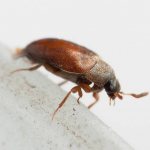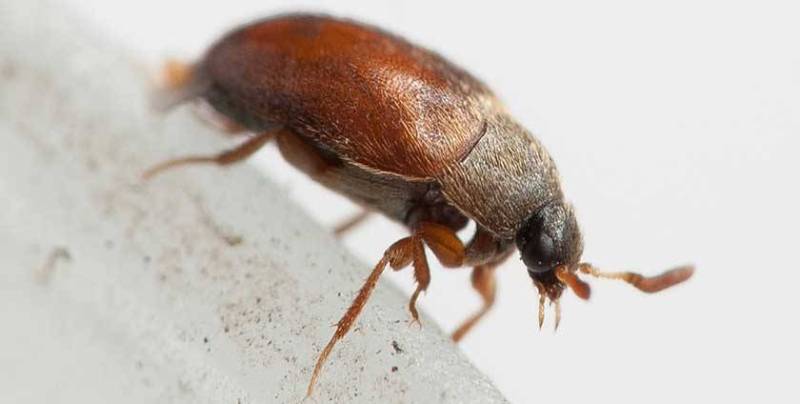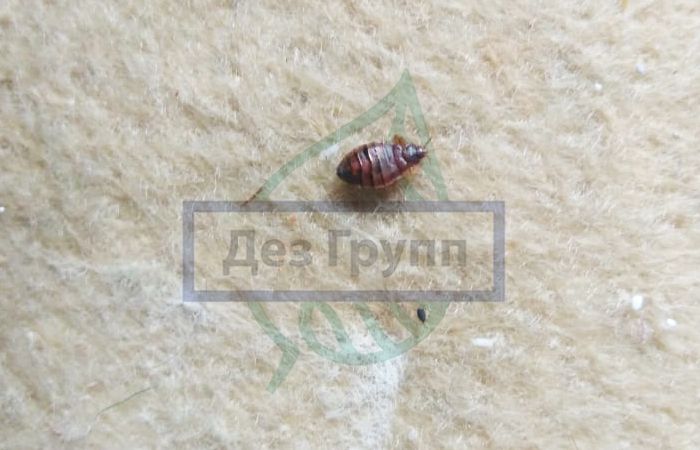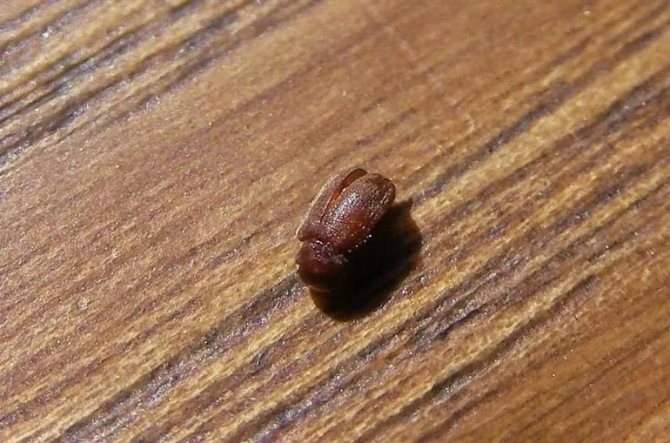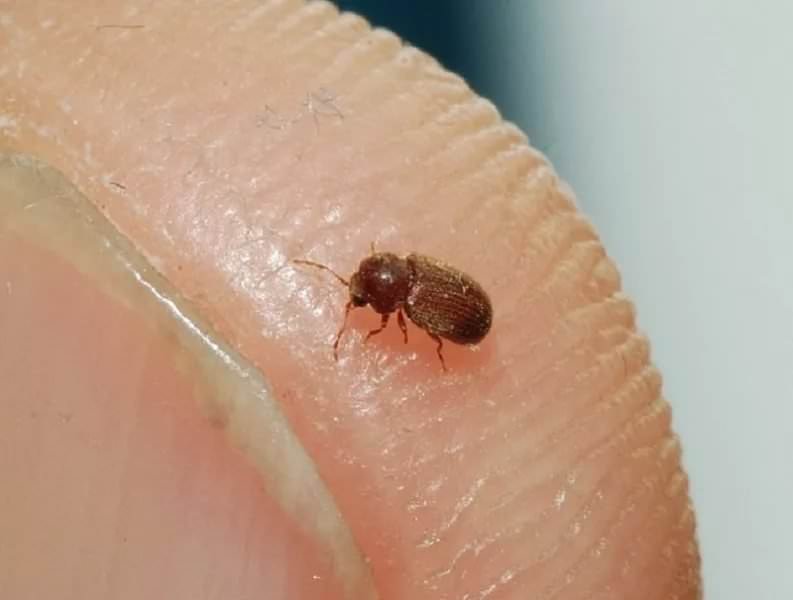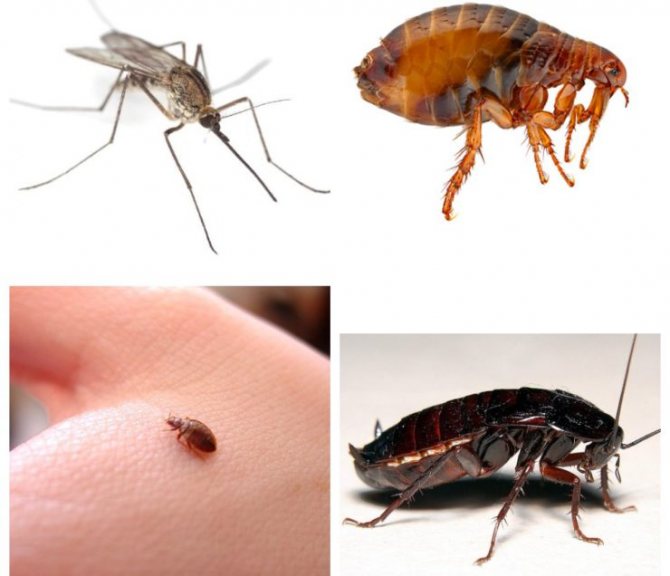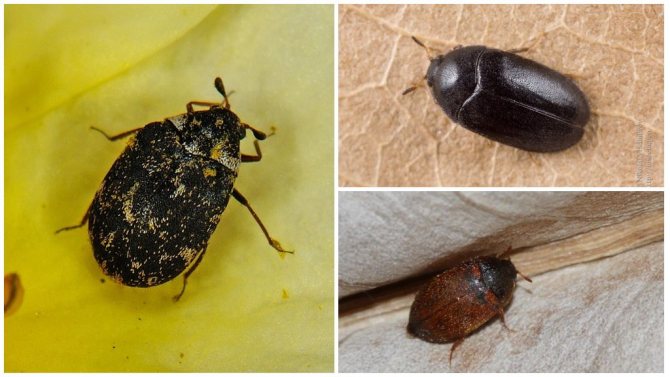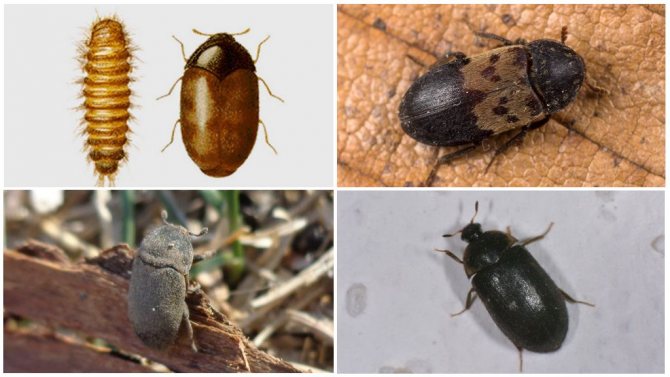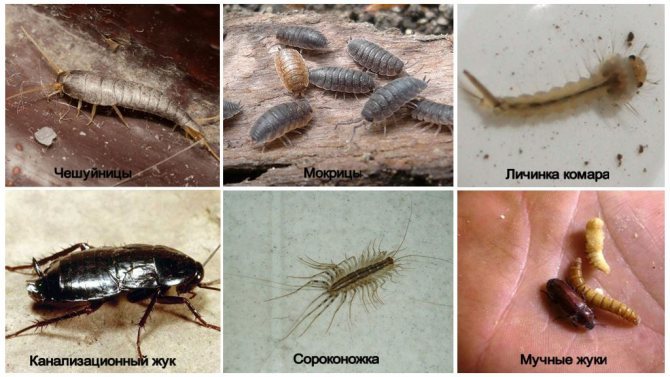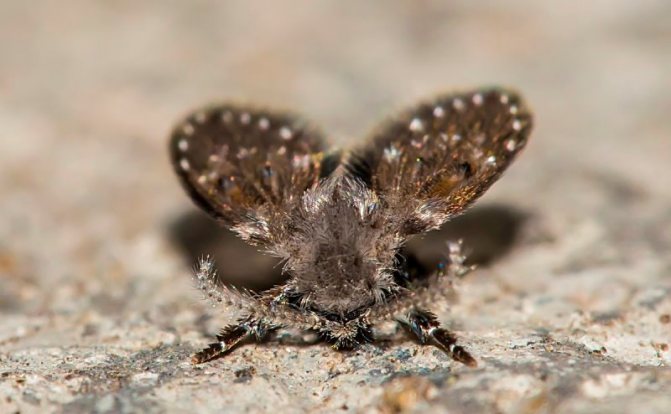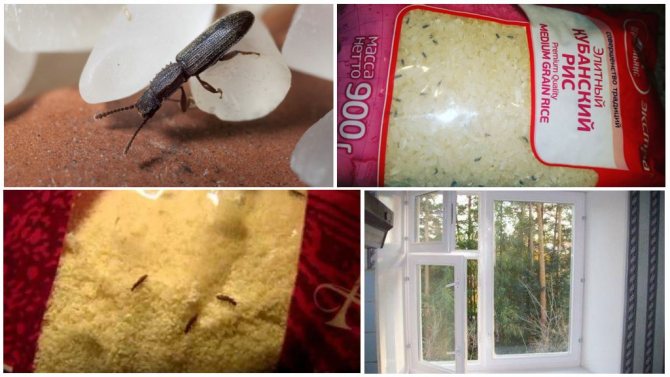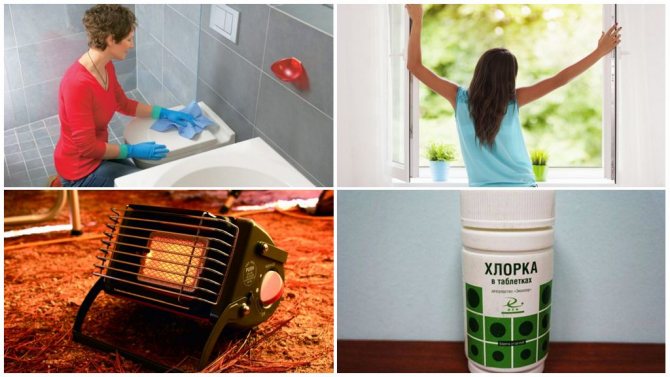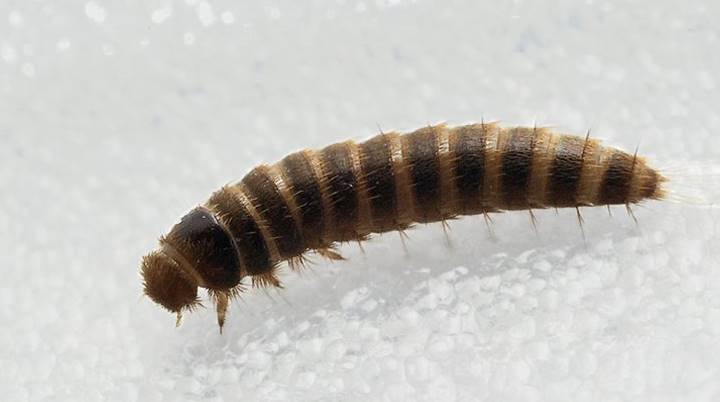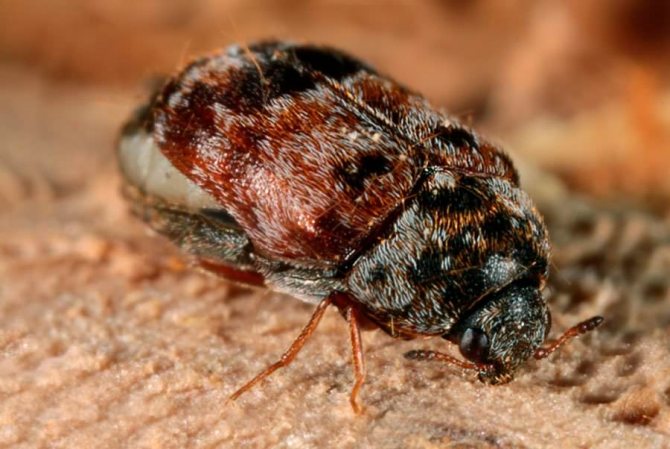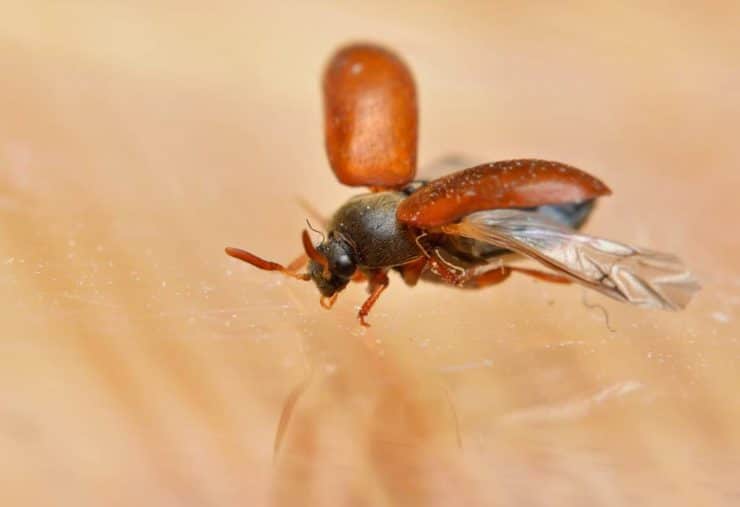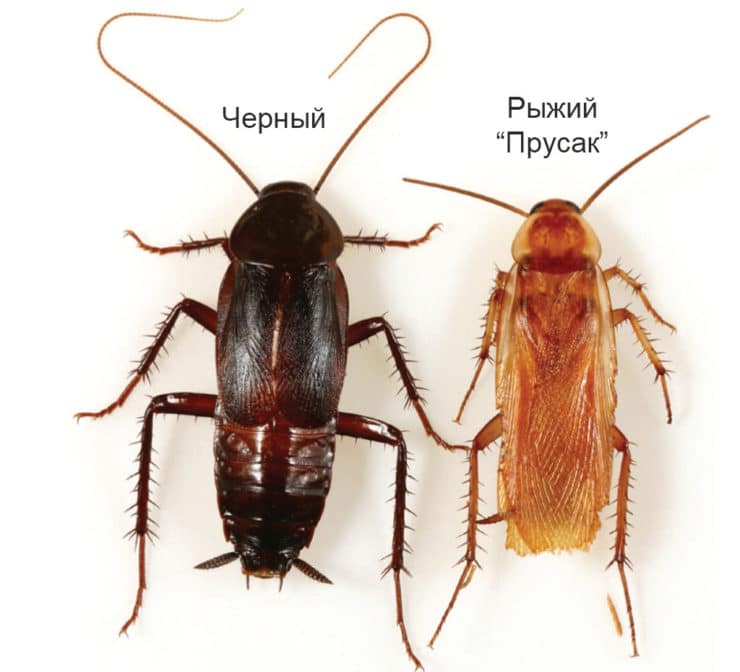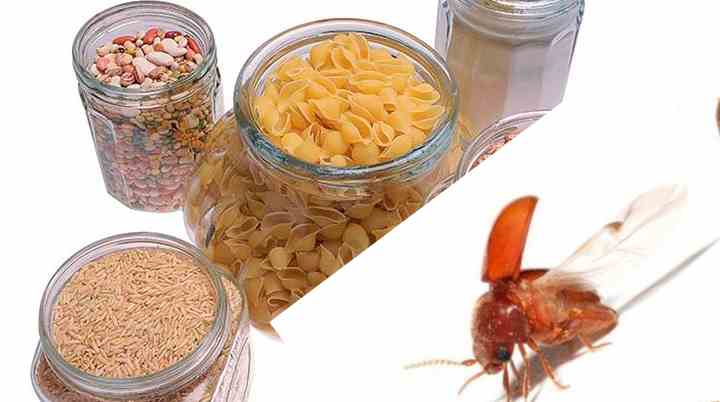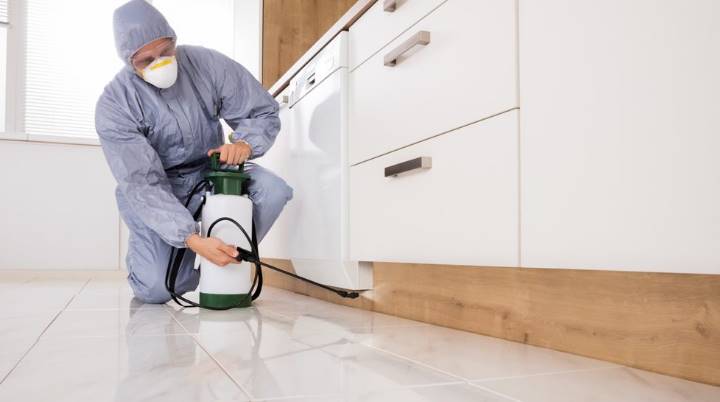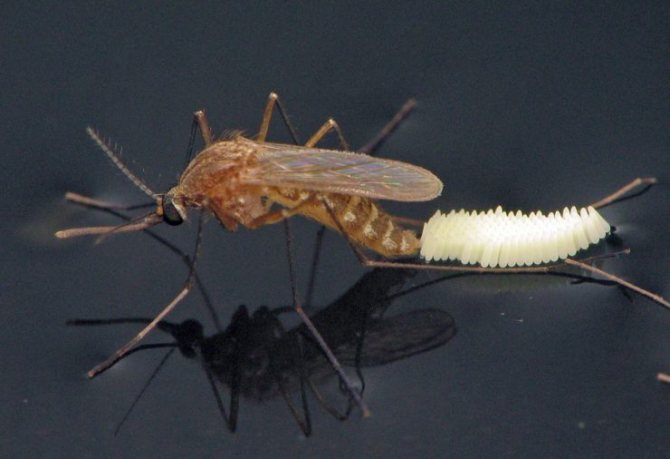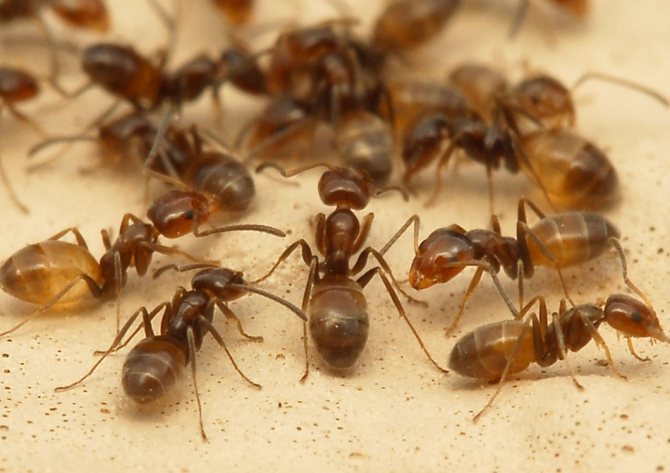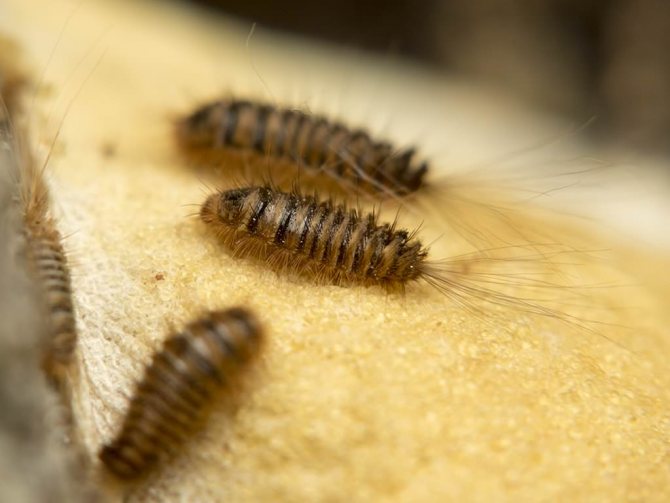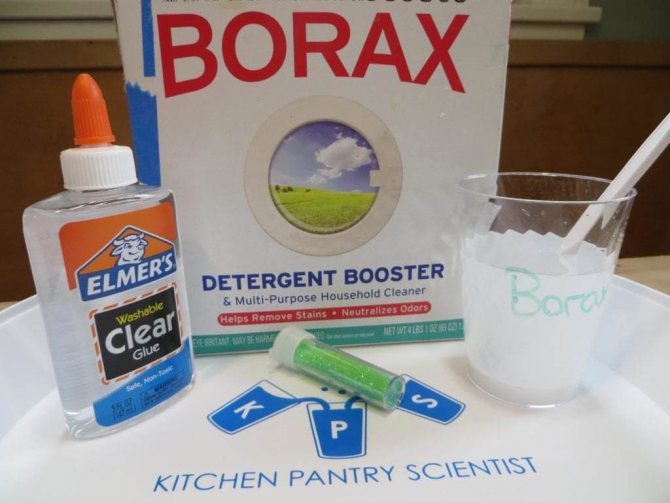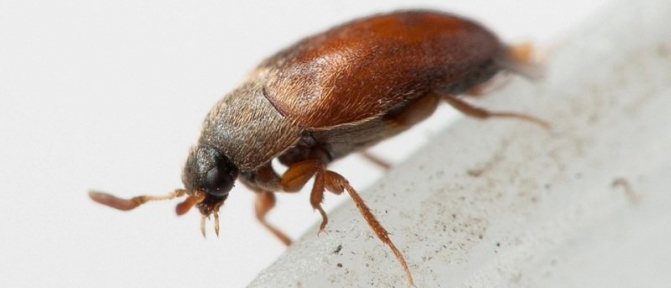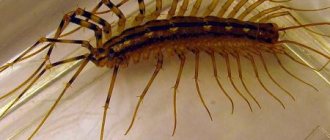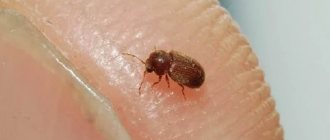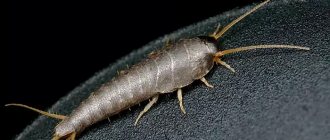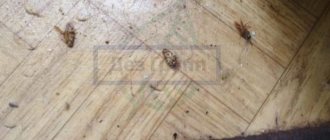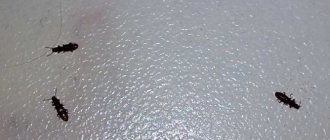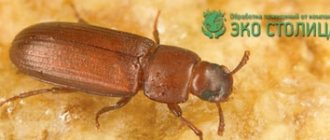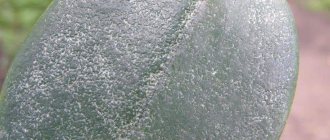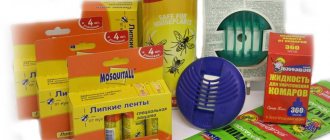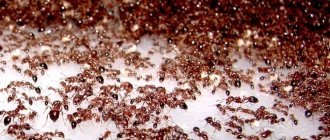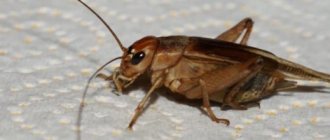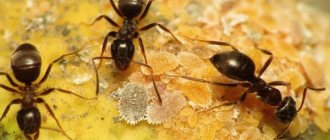general description
The small brown bug in the apartment is called "kozheed". The genus of these insects has more than 600 species. In natural conditions, they play the role of natural orderlies, destroying animal remains and plant debris. But, having settled in human dwellings, they immediately become the most dangerous pests.
Kozheedy are small flying bugs ranging in size from 1.3 to 13 mm. They have convex oval bodies of brown, gray and black color, sometimes with light, green and red stripes. Their abdomens are almost flat. Some species have true wings under rigid elytra. Elytra are sometimes covered with small scales or long hairs.
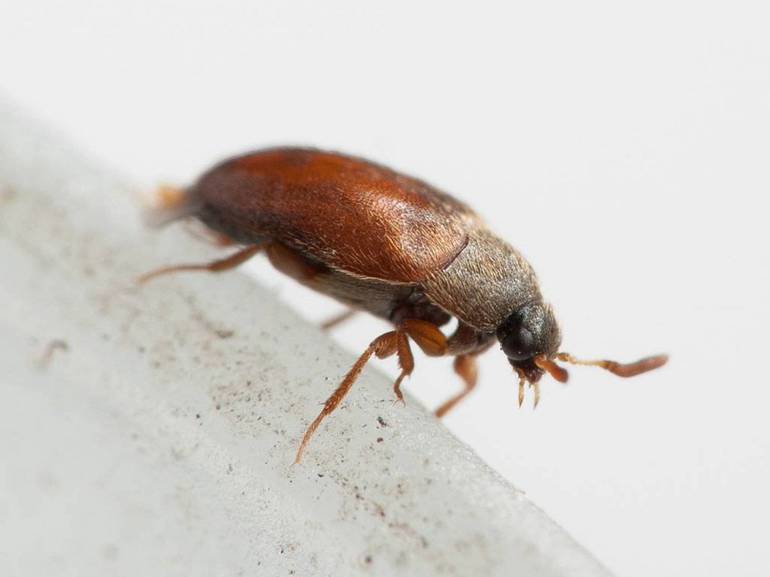
The range of kozheed is very wide. They live everywhere, except in cold areas and areas with high humidity. There are especially many of these insects in summer in dry steppes, deserts and semi-deserts, but they are not found in the tundra and in the humid jungles of South America. In the middle climatic zone, kozheedy are rare.
In apartments where the air is humid, kozheedy settle down reluctantly. They love warmth and dryness. Pests prefer places with dry and even dry air, so they can often be found near a central heating battery.
The insect's breeding cycle is one year. In the southern regions, there are species that produce offspring twice a year. In some species, the caterpillar develops over several years. After emerging from the egg, the larva molts up to 8 times. The pupa develops very quickly, from 4 to 20 days, depending on habitat conditions.
Grinders
If the ticking of a clock begins to sound from the side of the furniture, this is not a mechanical alarm clock forgotten somewhere. Grinder beetles started up in the furniture. The sound of "death clock" is produced by insect larvae that feed on wood. 2 types of grinders may appear in the apartment: furniture and brownie.
Furniture
Small brown bugs on a window sill made of wood may be furniture grinders leaving their shelters in the wood. The size of the imago is 2.7-4.5 mm. The body is cylindrical, elongated. Elytra with 10 clearly visible grooves. The body is covered with sparse light bristles.
The imago lives only 6-28 days. In the adult state, bugs do not feed, their only purpose is to leave offspring. The wood is eaten by larvae, which gnaw passages in it and pupate there.
Brownie
This beetle is unlikely to appear in the apartment, as it prefers frost-damaged wood. But residents of wooden private houses should be wary of him. Compared to other domestic parasites, it is a large insect: 4-7 mm. The color is dark gray with a brown tint. On sides of pronotum there are spots of golden bristles.
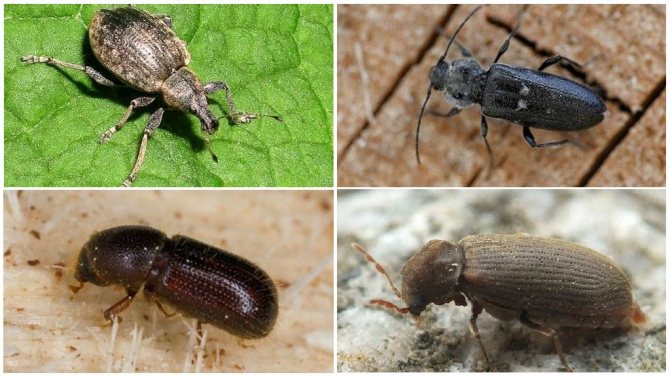

Weevil and grinders
Appearance in the apartment
Small brown bugs can fly into the room through windows and doors. They are most commonly found on windowsills in the kitchen, where they lay their eggs on the underside. This is due to the favorable conditions for the reproduction of larvae there, especially near the batteries.
The bugs quickly spread throughout the entire territory of the dwelling and are easily hidden due to the camouflage coloring. They multiply intensively under suitable conditions. Females lay translucent white eggs the size of a grain of sand for 2-10 days, after which they die. After 3 weeks, furry red caterpillars emerge from the eggs, which are actively feeding... Their food is:
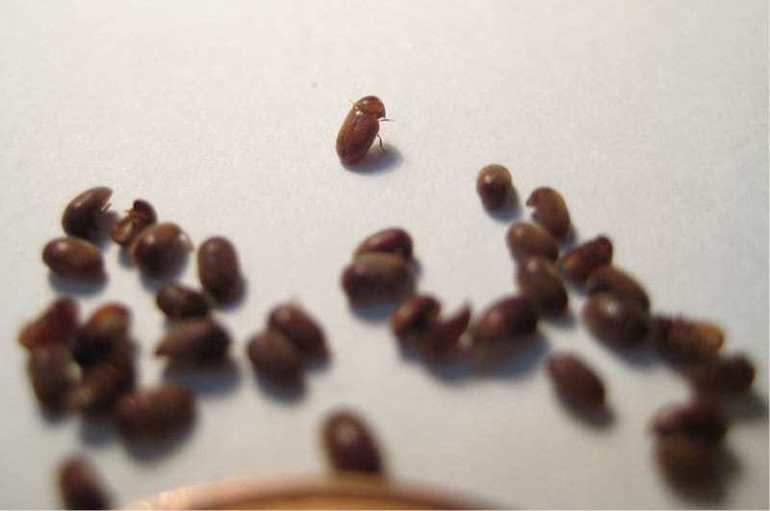

- cereals;
- pasta;
- cheese;
- meat;
- dried fish;
- fur;
- pen;
- natural fabrics;
- stuffed animals and other organics.
Kozheedy can wind up under the wallpaper and eat wallpaper glue there. Larvae can also be found in carpets, where they eat wool, dust, and organic debris.
Often, bugs fly into apartments due to the following external factors:
- cold snap or high humidity;
- reducing the amount of natural food.
Often kozheedy crawl in certain places. Their appearance is provoked by the following reasons:
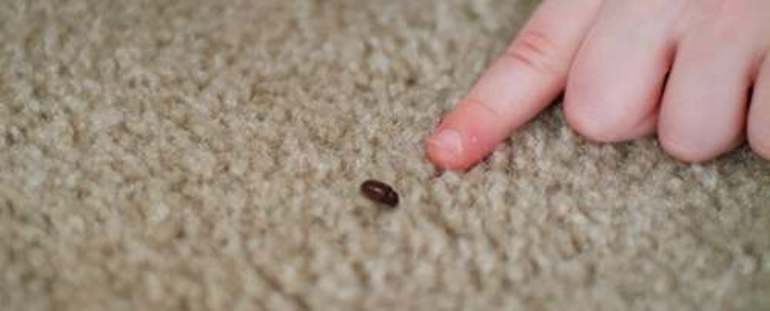

- dryness and warmth in the premises;
- stuffed animals and birds installed there;
- insect collections;
- old books in libraries;
- hairy animals living in the house, especially long-haired ones;
- a large number of fur and leather clothing;
- neglect of preventive measures against insect pests.
Pests don't just jump into homes through open windows and doors. Their distribution routes are as follows:
- ventilation ducts;
- things and products brought from the store, contaminated with skin;
- larvae caught in the fur of animals while walking.
Silverfish
Such small long insects are able to move very quickly on their numerous legs, penetrating into the narrowest cracks. They instantly hide when you turn on the light. Silverfish are ways to reproduce quickly enough, therefore, they pose a problem for apartment owners.
Their diet includes various substances: wallpaper glue, mold, book covers, sugar-containing foods, fabrics and leather (not synthetic), food leftovers, and even wet paper and rags. Due to their nocturnal lifestyle, it is difficult to spot silverfish at once.
Such gray-white beetles appear from dampness and for life they choose corners with high humidity for themselves. For humans, they are not dangerous: they do not bite because of a too small mouth, they do not spread bacteria.
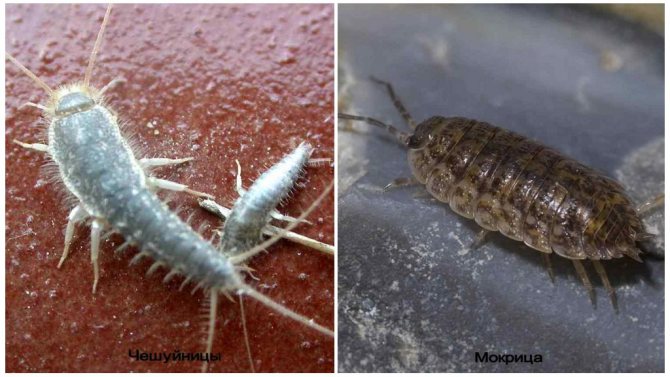

Silverfish and woodlice
Common types
The kozheedov living in houses are divided into several classes. They are as follows:
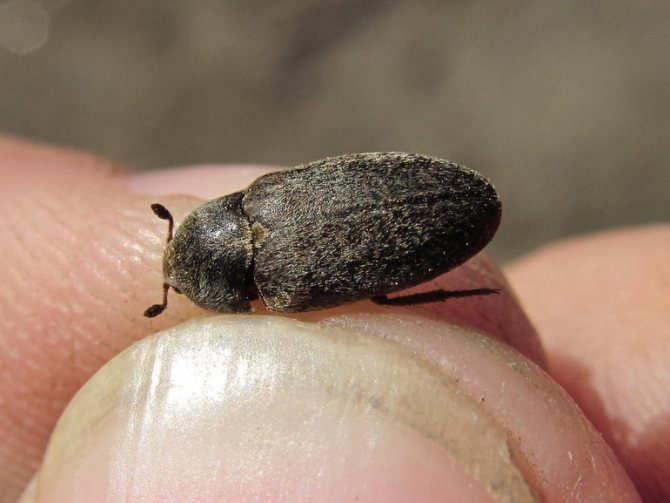

- Ham is the most common type of pest. Kozheedy eat almost everything, from organic matter to wood chips. They usually prefer meat and fish. These are dark, almost black, long beetles, reaching a size of 1 centimeter.
- Fur coat - black elongated beetles, on the elytra of which there are large white dots. They breed in dusty accumulations, where they feed on organic debris. Their length reaches 4-6 mm.
- Carpets - these insects live in food, leather, fur, feather pillows. They are brown in color, up to 5 mm in size.
- Cereals are tiny round insects up to 3 mm long. They are bred in cereals, grain, nuts, pasta.
- Spotted - these kozheedy, along with ham, are among the most dangerous species. They eat meat, fish, leather, fur. Their length ranges from 5 to 10 millimeters. Often, criminologists determine the age of the corpse by the insect larvae.
Kozheedy can be found in various household items: furniture, leather goods, fabrics, books and many other places. They eat not only organic materials, but synthetics as well.There are cases when these strange pests gnawed on cardboard, rubber, asbestos and cable sheath. They are often bred in houseplants.
Despite the extreme gluttony, kozheedy can do without food for up to 5 years. Their biological processes slow down, but their vitality remains.
Mucoedy
They belong to polyphagous beetles, that is, their menu is very diverse. Three types can be found in apartments.
We suggest that you familiarize yourself with White worms in the kitchen on the ceiling how to get rid of
Surinamese
The beetle is 3-3.5 mm long with a reddish-brown back. The pest is flat, very elongated, with a thin body. Pronotum with characteristic longitudinal ribs.
Prefers bakeries as a bottomless source of food. But often, along with flour and cereals, it gets into apartments, where it infects other supplies. The vital activity of bugs leads to an increase in moisture in the food, which is why mold forms in the cereals.
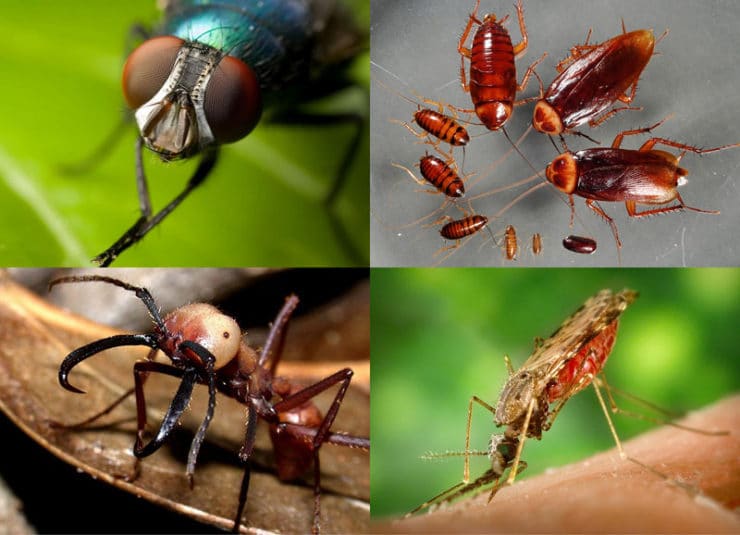

The maximum life span is 3 years. Typical 6-10 months. The life cycle is 27-51 days at a temperature of 29-35 ° C.
During her life, the female lays 43-285 eggs. At an ideal temperature of 27-29 ° C, the larvae hatch after 3-5 days. The larva grows up to 3 mm, has a yellow-white color and a brown head.
Red-haired muco-eater
The light brown beetle is about 2 times smaller than the Surinamese "fellow". In the apartment, the food supply, habitats and life cycle are similar to those of the Surinamese mucoed. A distinctive feature of the red muco-eater is inactivity.
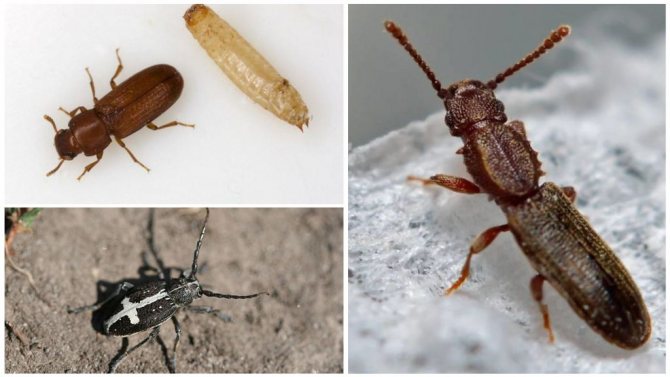

Mucoedy
Merchant beetle
A flat small beetle 2.5 cm long. Almost completely identical to the Surinamese in morphology and lifestyle, differing in the size of the eyes and the shape of the head. The bugs crawl actively, moving to new habitats.
Danger to people
Kozheedy not only spoil the food in the house, but also bite the people living there. Their bites are quite painful and dangerous for humans. Redness may appear on the damaged area, turning into inflammation. Pathogenic bacteria can enter the wound, which makes it fester.... The danger of a bite is also the following:
- the appearance of allergic reactions in people prone to them;
- infection with helminths and pathogenic bacteria.
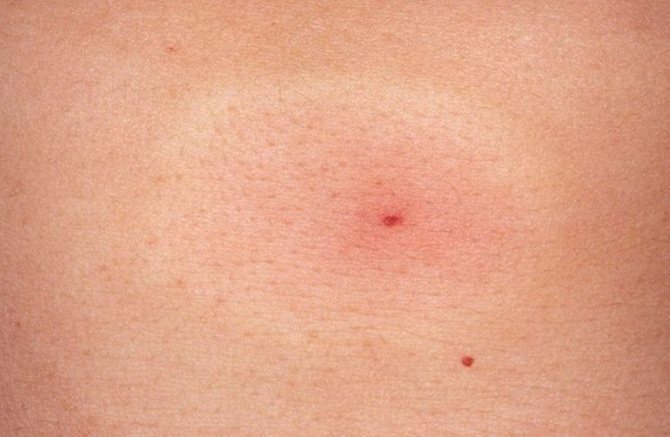

Doctors recommend treating the affected area with a disinfectant to prevent inflammation. It is especially unpleasant when bugs are bred in a bed in feather pillows or feather beds. In this case, the danger of a bite increases many times over.
Woodlice
These insects have an oval body of light gray, white, beige or brown color, convex from above, consists of several segments. The bug has 7 pairs of legs and a hard shell, and in front there are antennae up to half the length of the body. In nature, woodlice love humid places, from which they got their name, but sometimes they also settle near human dwellings. They can climb into the cellar and into some rooms in the house (bathroom or toilet) where there is high humidity.
Penetrating into living quarters, wood lice can not only scare people who are disgusted with insects that run quickly, but from moisture and mold they become carriers of various fungal diseases, and this is a danger to human health.
Therefore, it is imperative to deal with such moisture-loving insects, taking all possible measures to destroy them.
Getting rid of parasites
In order to effectively deal with uninvited neighbors, it is necessary to find out where they come from in the house and where they managed to get a divorce. The first one is quite difficult to find out, since bugs could fly in or crawl through a window, door or ventilation hole. Also, parasites could get from the street on the clothes and hair of animals, they could be brought along with purchased furniture, collected plants and mushrooms.
The location of the insects is easier to find out. This usually happens:
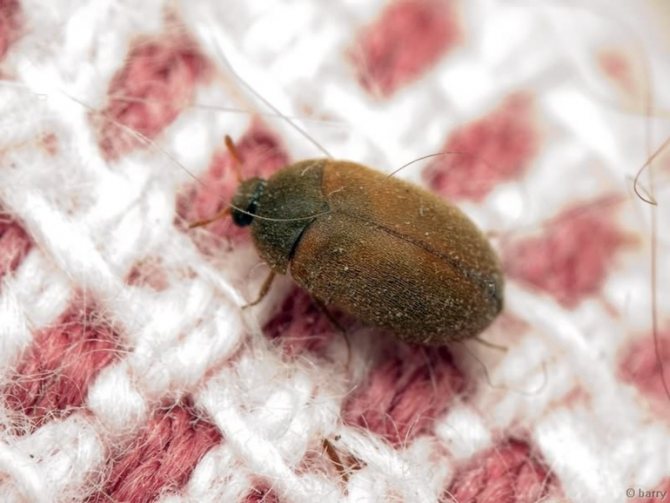

- carpets and rugs;
- the lower part of the window sills, especially if they are not plastic, but wooden;
- space behind the radiators;
- places behind skirting boards and door trims;
- places under the wallpaper, especially at the joints and the bottom;
- food products;
- beds, sofas, upholstery on upholstered furniture.
All these places need to be checked carefully. To get rid of parasites, you need to know their features:
- Insect larvae cannot stand bright light, they live in the dark.
- Adults are diurnal insects that fly in sunlight. Sometimes they appear under residential lighting.
- Kozheedy of any kind do not tolerate high humidity and low temperatures.
Small Khrushchak
The small flour beetle has a brown or red color of the body and causes considerable damage to the food supply of a person in an apartment. It is widespread in Russia and Ukraine, where it often becomes the culprit for grain spoilage in granaries, mills and other places where bulk products are stored.
We suggest that you familiarize yourself with: Scabbard on indoor plants - how to deal
The red-brown beetle is smaller (up to 3.6 mm), but it loves to settle in various food supplies in the apartment: in flour, nuts, dried fruits and other plant fruits.
The larva of the small beetle is flat and up to 7 mm long, the body color is yellow-brown (light or dark shades), the head is flattened. The body is covered with hairs and ends with 2 spines. The pupa is colored light yellow, and its body is shiny and completely naked. The development cycle of a flying black beetle is 20-120 days, and the growth rate directly depends on the amount of food and living conditions.
Control methods
There are various ways to deal with skin debris.... The following measures help from pests:


- Thorough cleaning in habitats of bugs and their larvae. The collected insects are destroyed.
- Freezing the room. The bugs cannot tolerate temperatures below -11 ºС for more than 3 hours. This method is not suitable for city apartments, but it can be used in a rural house.
- Steam generator treatment of furniture, feather-filled items, fur clothing. With its help, bugs, larvae and eggs are destroyed. The contaminated cotton clothing is simply boiled.
- Throwing away old things and furniture. This is the most radical way to combat skin problems.
Boric acid is sprinkled over the infected areas. This tool helps to remove many parasites, including kozheedov. To combat bugs, chemical powders and moth aerosols are also used:
- "Antimol";
- Raptor;
- "Raid";
- "Clean House" and others.
It should be noted that these drugs are addictive in insects, so they need to be changed regularly.
Small brown bugs in the apartment do a lot of harm: they spoil food and things, they can bite heavily. Getting rid of them requires patience and perseverance.
Red bug
Home flowers are a separate topic: they not only give the living space freshness and attractiveness, but also bring a lot of inconvenience due to the detection of gluttonous red bugs on the leaves, for example, lilies. The insect belongs to the leaf beetle family, the genus Lilioceris. Crackling beetles tend to eat the leaves of houseplants in large numbers.
There are bulbous and lily insect varieties called "firefighters". The pest is able to destroy the entire flower garden before leaving only the stems. In order to preserve plants, it is advisable to carry out preventive measures to prevent their appearance and conduct an active fight against insects.
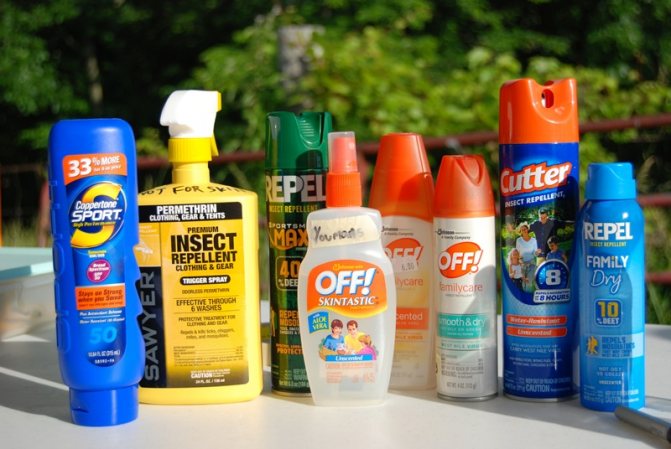

House beetles
Even in a clean apartment there are uninvited six-legged and eight-legged guests, and what can we say about microscopic neighbors that can be on the skin of people and animals.They usually enter the house through windows, window sills, any crevices, drainpipes, ventilation openings. No human habitation could do without their presence.
In the kitchen, you can most often find:
- Cockroaches;
- Weevils;
- Ants;
- Senoyedov;
- Fruit flies;
- Flour Khrushchaks.
Cockroaches are the fastest and most hardy creatures that have lived on earth for 4 million years and have 4,000 species. They move at a speed of about 400 km / h, can not breathe for about an hour and go without food for 1 month.
Weevils. They pierce any packaging with their proboscis. These insects breathe with the help of microscopic holes in the skin. Hiding from direct sunlight in boxes of cereals, they lay up to 400-500 eggs.
Ants often enter apartments with fruits and vegetables from the home garden. They feed on the remains of human food. The bites of some of the ant species are very painful to humans. Therefore, it is better to get rid of them quickly. This is fairly easy to do by spraying the area with insect spray.
Hay-eaters appear in any premises with constantly high humidity. They are small fragile white insects with transparent wings. They eat organic food, but they can go without food for a long time. Mold is a favorite treat that attracts hay-eaters in an apartment. You can get rid of their presence by eliminating hotbeds of constant dampness.
Fruit flies. Their larvae develop in plant debris: fruits, vegetables, etc. They are also called fruit flies. Like flies, they carry infections. Swarms of flies may appear over rotten fruit. They should be disposed of by throwing out garbage in time and observing the rules for storing and processing fruits and vegetables.
Flour beetles. An adult beetle reaches 12-19 mm in length. Its body is flat, light brown and reddish underneath. Their larvae are 2 mm in size, yellow in color and have no eyes. They eat cereals, flour. In addition to grain and flour, the beetle can start in starch, dried fruits, seeds, and also feed on fabric, wool.
The bedroom is most often inhabited by:
- Dust mites;
- Lice;
- Bed bugs;
- Skin-eating beetles.
Ticks are creatures that feed on particles of dead skin. Therefore, bed linen, mattresses, sofas and pillows for them are like a 24-hour dining room. On average, there can be about 10 billion individuals in the bed of each person. Dust mites cause allergic reactions in people with asthma.
Kozheed. In his body there are enzymes that can process keratin. The larvae of the kozheed eat wool, thereby spoiling woolen things. But at the same time, they can be useful, as they eat dead insects and lost hair.
Lice. Contrary to popular belief, lice start in clean hair. Clean hair is easier to navigate as it glides less due to the lack of fat on it. Lice are more common in long hair than in short ones, because it is more convenient to attach to them. They cling to the hairs with the help of six legs with claws. On average, no more than 5-10 individuals live on an infected head.
Lice cocoons are still in the hair. The louse, being on the head for about a month, lays many eggs. If the lice are not removed in time, then everyone around them can become infected. Insects drink blood at least once a day. Lice saliva prevents blood clotting. Initially, the body of a young individual is colorless, but its color changes after the first meal.
Body lice hide in the folds of dirty clothes. Their lifespan is twice that of head lice. They are more prolific. Dangerous diseases can be transmitted through their dried excrement. For example, a body louse can transmit typhoid and other diseases.
Fleas. Thanks to its flat, armored body, the flea easily penetrates the fur of animals. With its large jaws, it pierces the skin and blood vessels.Two pumps in her head help her suck blood. Fleas move with the help of several pairs of legs, can jump up to 20 cm. These parasites are carriers of many diseases, the most dangerous of which is the plague.
Bed bugs are parasites of warm-blooded animals and people, they feed on their blood. Supposedly, they originally existed in caves. Bed bugs feed on blood at all stages of development. Most people do not notice bedbug bites. It is possible to find bugs in bed only by numerous brown spots. With a strong infection of the room with bedbugs, a specific smell may appear.
Mosquitoes are blood-sucking insects. Moreover, only females feed on blood. Their upper and lower lips are elongated and form a kind of pencil case, in which there are sharp and thin needles. Unlike females, in males these organs are poorly developed and they do not bite, but feed only on plant sap. Mosquito larvae and pupae live in stagnant water bodies. In cities, they fill warm and humid rooms, for example, the basements of residential buildings.
Harmless insects
Such insects can be found in the bathroom at home:
- Silverfish;
- Woodlice;
- Pintail;
- Flycatchers;
- Spiders;
- Centipedes.
Woodlice is a garbage-collecting insect. Its body, covered with "armor", reaches a length of no more than 20 mm. They eat rot, mold, excrement, and members of their own species. Six times a year, they shed their shells, becoming completely defenseless. To absorb oxygen, their gills, which are located on the abdomen, must remain moist.
These insects are able to suck in water at both ends: through the mouth and tubes near the rectum. Due to the high calcium content in their shells, there was a time when these insects were sold in pharmacies as a cure for indigestion. So they got the name "pill beetles".
Silverfish. Little bugs that eat literally everything thanks to their body's ability to produce cellulase - a cleavage enzyme. These microscopic black bugs can be seen on the spreads of books. They are also called bookworms.
Pintail. Another name for this insect is earwig, or tick. Also, the most common name is a pinch. It is an omnivorous insect. In apartment buildings, they are most likely attracted by the presence of a variety of food and other insects that they also feed on (or rather, their remains). The length of the pintail reaches 12-17 mm. Long antennae extend from the head. They can fly, but are reluctant to use their wings.
Flycatchers. They start up in different rooms, like furry caterpillars. They move quickly, feed on other insects: flies, mosquitoes, midges, silverfish. They can bite in self-defense.
Spiders weave their silk web using special glands. The thread they throw out hardens on contact with air. They calmly move along their web, waiting for the victim. If the victim is caught, then she will not get out. The cobweb in the corners looks unaesthetic, but still the benefits of the spiders themselves are undeniable. They kill harmful insects. Many spiders catch and eat insects twice their own weight per day.
We suggest that you familiarize yourself with How to wash washable wallpaper at home
Centipedes. The millipede length ranges from 2 mm to 30 mm. Centipedes are a superclass of invertebrates, although they are mistakenly considered insects by some. Kivsaki is one of the types of millipedes common in Russia. They look very impressive because they look like a long black smooth caterpillar with a lot of legs.
Ticks are creatures that feed on particles of dead skin. Therefore, bed linen, mattresses, sofas and pillows for them are like a 24-hour dining room. On average, there can be about 10 billion individuals in the bed of each person. Dust mites cause allergic reactions in people with asthma.
We suggest you familiarize yourself with: Black caterpillar with a horn
Harmless insects
Home thermobia
In living spaces, insects, called silverfish, often start and settle for a long period of an unpleasant appearance. The bugs are devoid of wings. An oblong body with a small head with antennae and three tails in the form of processes causes frank dislike in people. They are hammered into the darkened corner holes. Home thermobia settles in the bathrooms of apartments and country houses, harming objects and coatings.
Aerosol products produced by the current industry are suitable for the destruction of all types of household pests. Useful drugs are intended as effective protection or preventive measures.
Small insects in the apartment are not uncommon. And it's not just fleas and cockroaches. But, given a certain precaution and following the clear instructions of the instructions when dealing with all kinds of bugs, it is possible to achieve the desired effect, and no worms in the apartment will start. Remember that only the owner will cope with the problem who will take the problem with full responsibility.
Legtail
Silverfish are often confused with woodlice. They have an elongated flat body, with long antennae. Covered with scales, body length up to 19 mm. Safe for humans and animals, but may damage books, clothing and food. They live more often in the bathroom, as they like dark and humid places. During the day, they prefer to hide in the cracks of baseboards, frames, cabinets, etc.
If there are not many silverfish in the house, you can try installing a sticky burdock - for example, for cockroaches. To attract silverfish, you can put a piece or other starchy product inside.
You can also fight silverfish with pyrmethrin-based insecticidal aerosols. It is important to remember that they cannot be used in places where food is stored. You can also sprinkle diatomaceous earth over areas where silverfish are common, and then vacuum. It is important not to let children and animals into the treated room.
Where do fleas come from?
There are various examples of blood-sucking insects. Fleas are one of them. They appear in homes where pets live. Insects gradually colonize the space. They live at a level of 1-1.5 m, because they cannot fly, but can only jump high. Fleas cause inconvenience not only to animals, but also to people, as they bite all warm-blooded creatures, even birds.
A flea bite provokes severe itching. As a result, in the places of contact with them, scratches are formed, and in their place - pustules. Insects bite at any time of the day, the nature of the bites is chaotic, so it is difficult to determine who exactly attacked. For example, bed bugs leave red dots in the form of a path. In addition, these parasites usually attack exposed and non-hairy areas of the body. Fleas, on the other hand, are less picky, so their bites can be found anywhere.

